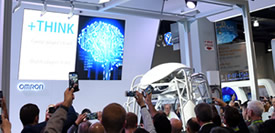OMRON Releases World’s First Mass-Producible Polymeric Ultra-Wideband (UWB) Antenna
- Optimizing data transmission between PCs & other digital home appliances -
- Combines compact size with high performance utilizing OMRON's proprietary dielectric polymer molding technology -
FOR IMMEDIATE RELEASEMay 15, 2006
TOKYO, Japan - OMRON Corporation (TSE: 6645, US: OMRNY), a global leader in electronic components, sensing and control technologies, announced that it will launch a new SMD Polymeric Antenna (type: WXA-N1SL) for short-range, wireless Ultra-Wideband (UWB) applications. Product launch is scheduled for 1 June, 2006. [Image]
Driven by consumer demand for simple wireless functionality, “point-and-shoot” usability and increasingly mobile lifestyles, the wireless communications market, led by Bluetooth™ and wireless LAN, has shown phenomenal growth over the past few years. UWBi is now attracting particular attention as a solution for high-speed, high-volume reliable data transmission over short distances.
UWB is a recently commercialized short-range wireless technology, expected to be widely adopted in consumer goods. Applied in dongles, personal computers, printers, mobile telephones, digital televisions and DVD players, UWB functions as a low-power-consuming wireless USB (universal serial bus), allowing users to transfer large amounts of data rapidly between various devices in close range. For example, UWB makes it possible to transmit high-definition video data wirelessly between a high definition digital TV and DVD player, thereby eliminating the need for expensive and unsightly wires.
Due to the wide frequency range on which UWB operates, electronic devices need to be equipped with a special ultra-wideband antenna for UWB-compatibility. While various antennae are currently in the market, OMRON’s new SMD Polymeric Antenna (type: WXA-N1SL) combines both compact size with high-performance, utilizing the company’s proprietary molding technology and dielectric polymer material. As a result, with OMRON’s antenna, ODMs and OEMS deploying UWB can benefit from flexibility of antenna shape design without compromising on size or performance. Capitalizing on its expertise in precision manufacturing, OMRON has now succeeded in mass production of the antenna at its factory in Shiga prefecture, Japan.
SMD Polymeric Antenna: type WXA-N1SL is optimized for WiMedia™ Alliance’s UWB common radio platform as well as for the Certified Wireless USB specifications from the USB Implementers Forum (USB-IF). OMRON will also work to optimize all future versions of the antennae for the recently announced next-generation BluetoothTM-Over-UWB platform.
OMRON has been collaborating closely with many of the UWB chipset companies over the past 12 months, including San Diego, California-based Staccato Communicationsii, a UWB technology pioneer and Certified Wireless USB leader.
“OMRON's production-ready N1 UWB antenna offer a small form-factor, high performance and low cost solution for our customers that complement our Ripcord single-chip, all-CMOS products based on Certified Wireless USB," said Jason Ellis, Director of Business Development, Staccato Communications. "OMRON's antennae were accepted for inclusion and have been shipping with our Ripcord Development Kits."
OMRON aims to achieve sales of 3bn Japanese yen for the WXA-N1SL antenna in FY2008. By maximizing the mass production potential and flexibility of its proprietary dielectric polymer molding technology, the Japanese manufacturer plans to further enhance its WiPlaDsiii series of wireless polymeric high-frequency devices including antennae to cover a wider range of device applications.
Antenna Specifications
| Model No. | WXA-N1SL |
|---|---|
| Size (L x W x H) | 12 x 5 x 1.1 mm |
| Frequency Range | 3.1 ~ 4.9 GHz |
| V.SWR | Max. 2.5 |
| Gain | Max 0dBi |
Product availability is scheduled for after 1 June, 2006.
- UWB (Ultra-wideband) is a next-generation wireless transmission technology. UWB standards that allow for data rates of up to 480 Mbps at a range of 3 meters and below, or up to 110 Mbps at a range within 10 meters, are currently being developed.
- Staccato Communications is an Ultra-Wideband (UWB) technology pioneer with applications expertise in Certified Wireless USB, Bluetooth and Internet Protocol (IP) connectivity. For more information, please visit www.staccatocommunications.com
- WiPlaDs is a registered trademark for OMRON’s wireless high-frequency devices. The name derives from “Wireless Polymeric Advanced Devices. ”All other trademarks are the property of their respective owners.
About OMRON
Headquartered in Kyoto, Japan, OMRON Corporation is a US$5.5bn global leader in the field of automation. Established in 1933 and headed by President and CEO Hisao Sakuta, OMRON has more than 27,000 employees in over 35 countries working to provide products and services to customers in a variety of fields including industrial automation, electronic components, social systems (ticket gate machines, ticket vending machines, and traffic control), and healthcare. The company is divided into five regions and head offices are in Japan (Kyoto), Asia Pacific (Singapore), China (Shanghai), Europe (Amsterdam) and US (Chicago). For more information, visit OMRON’s website at www.omron.com.
- For media related enquiries, please contact:
- Takayuki Nakamura (takayuki_nakamura@omron.co.jp)
James Seddon (james_seddon@omron.co.jp)
at OMRON Corporate Communications Department
Telephone: +81 3 3436 7202






